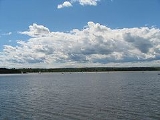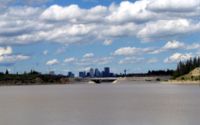
Glenmore Reservoir
Encyclopedia
The Glenmore Reservoir is a large artificial reservoir on the Elbow River
in the southwest quadrant of Calgary, Alberta. The Glenmore Dam is the concrete structure that holds back the reservoir. The reservoir is a primary source of drinking water to the city. Built in 1932, with a cost of $3.8 million, the dam
controls the downstream flow of the Elbow River, thus allowing the city to develop property near the river's banks with less risk of flood
ing.
 The City of Calgary offers sailing
The City of Calgary offers sailing
lessons and boat rentals on the reservoir.
The reservoir is home of the Glenmore Sailing Club
, for both social and organized sailing events in Calgary. Swimming in the reservoir is not permitted.
The reservoir has a water mirror of 3.84 km² (1.5 sq mi) and a drainage basin of 1210 km² (467.2 sq mi). It has a mean depth of 6.1 m (20 ft) and reaches a maximum depth of 21.1 m (69.2 ft).
originally settled at the location of the reservoir, and he gave the name Glenmore (Gaelic for "big valley") to this area.
The dam was completed on 31 January 1933. When the area flooded (by the summer of 1933), part of the Livingston house was preserved and now stands in Heritage Park
, which borders on the reservoir.
2005 flood
Although the dam usually provides effective flood protection, a major flood
in June 2005 caused the reservoir to exceed its capacity. The excess spilled over the dam and into the river. The flow downstream increased from its normal average of 20-30 cubic metres per second up to 350 cubic metres per second. As a result, some roads were closed and 2,000 Calgarians who lived downstream were evacuated. The Glenmore water treatment plant had difficulty treating the heavily silted water. Ironically, this caused the municipal government to issue water restrictions. The Alberta government
estimated the floods in the area to be the heaviest flooding in at least two centuries.
Elbow River
The Elbow River is a river located in southern Alberta, Canada. It flows from the Canadian Rockies to the city of Calgary, where it merges into the Bow River....
in the southwest quadrant of Calgary, Alberta. The Glenmore Dam is the concrete structure that holds back the reservoir. The reservoir is a primary source of drinking water to the city. Built in 1932, with a cost of $3.8 million, the dam
Dam
A dam is a barrier that impounds water or underground streams. Dams generally serve the primary purpose of retaining water, while other structures such as floodgates or levees are used to manage or prevent water flow into specific land regions. Hydropower and pumped-storage hydroelectricity are...
controls the downstream flow of the Elbow River, thus allowing the city to develop property near the river's banks with less risk of flood
Flood
A flood is an overflow of an expanse of water that submerges land. The EU Floods directive defines a flood as a temporary covering by water of land not normally covered by water...
ing.

Sailing
Sailing is the propulsion of a vehicle and the control of its movement with large foils called sails. By changing the rigging, rudder, and sometimes the keel or centre board, a sailor manages the force of the wind on the sails in order to move the boat relative to its surrounding medium and...
lessons and boat rentals on the reservoir.
The reservoir is home of the Glenmore Sailing Club
Glenmore Sailing Club
The is the home of sailing and racing in Calgary - with a strong focus on its Wednesday Evening Racing Series and club-level regattas and regional regattas...
, for both social and organized sailing events in Calgary. Swimming in the reservoir is not permitted.
The reservoir has a water mirror of 3.84 km² (1.5 sq mi) and a drainage basin of 1210 km² (467.2 sq mi). It has a mean depth of 6.1 m (20 ft) and reaches a maximum depth of 21.1 m (69.2 ft).
History
Calgary pioneer Sam LivingstonSam Livingston
Samuel Henry Harkwood Livingston came to Canada following an unsuccessful venture in the Californian gold rush of 1849, and eventually found his way to Jumping Pound, Alberta in 1873 where he opened a trading post...
originally settled at the location of the reservoir, and he gave the name Glenmore (Gaelic for "big valley") to this area.
The dam was completed on 31 January 1933. When the area flooded (by the summer of 1933), part of the Livingston house was preserved and now stands in Heritage Park
Heritage Park Historical Village
Heritage Park Historical Village is a historical park located in Calgary, Alberta. The park is located on of parkland on the banks of the Glenmore Reservoir, along the city's southwestern edge. As Canada's largest living history museum by number of exhibits, it is one of the city's most visited...
, which borders on the reservoir.
2005 flood
Although the dam usually provides effective flood protection, a major flood
Flood
A flood is an overflow of an expanse of water that submerges land. The EU Floods directive defines a flood as a temporary covering by water of land not normally covered by water...
in June 2005 caused the reservoir to exceed its capacity. The excess spilled over the dam and into the river. The flow downstream increased from its normal average of 20-30 cubic metres per second up to 350 cubic metres per second. As a result, some roads were closed and 2,000 Calgarians who lived downstream were evacuated. The Glenmore water treatment plant had difficulty treating the heavily silted water. Ironically, this caused the municipal government to issue water restrictions. The Alberta government
Politics of Alberta
The politics of Alberta are centred on a provincial government resembling that of the other Canadian provinces, namely a constitutional monarchy and parliamentary democracy. The capital of the province is Edmonton, where the Lieutenant Governor, Premier, the legislature, and cabinet reside.The...
estimated the floods in the area to be the heaviest flooding in at least two centuries.
Facts and figures
- The Glenmore Water Treatment Plant, constructed in three phases in 1933, 1957 and 1965, is a conventional treatment plant that gets its water from the Elbow river. The Glenmore plant supplies drinking water to south Calgary.
- The reservoir is maintained at a level, depending on the flow rate of the Elbow river, that minimizes the risk of flooding around the reservoir and downstream of the dam to the greatest degree possible.
- The dam, one of the heaviest in North America, is 320 metres long with a base width of 21 metres.
- William Gore and Bill Storie designed the Glenmore Dam.
- Dams such as Glenmore use the downward force (gravity) of the weight of the construction materials,(concrete), to resist the horizontal force of the water they hold. These massive dams resist the thrust of water entirely by their own weight.
- In deep water, there is more water "piled up,"causing the pressure to be greater at the bottom than at the surface. A dam's design must enable it to withstand greater pressure at the bottom than at the top.
- During periods when the rate flow of the Elbow River reaches dangerous levels, water may be released from the dam to prevent overflow.

